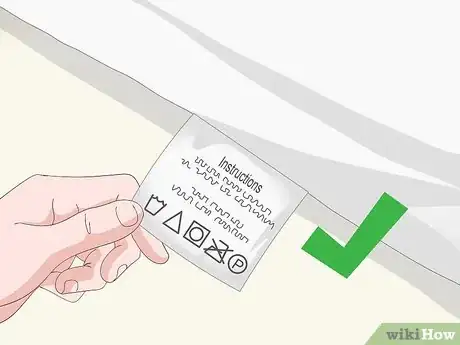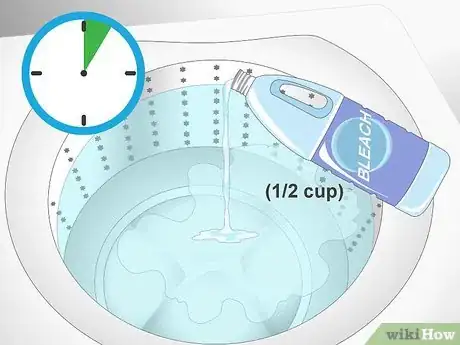This article was co-authored by Susan Stocker. Susan Stocker runs and owns Susan’s Green Cleaning, the #1 Green Cleaning Company in Seattle. She is well known in the region for outstanding customer service protocols — winning the 2017 Better Business Torch Award for Ethics & Integrity —and her energetic support of green cleaning practices.
There are 11 references cited in this article, which can be found at the bottom of the page.
This article has been viewed 217,139 times.
White clothes can be hard to maintain, especially since stains are often impossible to hide on white fabric. As whites become soiled and worn, you might consider throwing them away. But think twice before you do! There are several effective ways to get your stained whites clean and whiter, in addition to strategies to keep them bright in the long term. Try pre-soaking techniques with natural ingredients, add in additional products to your regular wash, separate your whites from colored clothes, and air-dry for best results!
Steps
Applying Pre-Wash Treatments on Stained Whites
-
1Apply liquid enzyme detergent to stains prior to washing. If you spilled soup over your white t-shirt or noticed the armpit sweat stains after wearing it, attack those spots immediately without letting them set. Rub some liquid enzyme detergent on the stained area, and let your t-shirt wait for 15 minutes or more before washing it with your laundry.[1]
- Read the description on the detergent bottle to ensure that it includes different enzymes designed to fight dirt.
-
2Presoak your discolored whites with washing soda in hot water. If your white shirts lost their brightness or got discolored, put them in a bucket full of hot water and ½ cup of washing soda. Let them sit up to a day, and throw them in the washer.[2]Advertisement
-
3Remove tough stains with a presoak of lemon juice, salt, and washing powder. Prepare a hot water soak with 1 tablespoon of salt, the juice of 3 lemons, and ¼ cup of washing powder. Have your clothes in the presoak for 45 minutes, and then rinse them a few times.[3]
-
4Rub sweat marks with baking soda and lemon. To counter the yellowing of whites due to perspiration, pour 1 tablespoon of baking soda onto the sweat area. Cut a lemon in half, and rub its cut side onto the same spot. Let it sit for 15 minutes, and wash as normal.[4]
- This method works for rust stains as well, though you should let the cloth sit overnight. The next day, rinse it with cold water, since hot water might let the rust set instead. Repeat if the stain persists.[5]
-
5Remove a red wine spill with salt and club soda. Red wine stains on a nice white shirt can look especially alarming, but if you handle the stain immediately, you might have a shot at salvaging your shirt! Pour salt onto the spot so it absorbs the moisture. Wait for 10 minutes, then scrape the salt off. Wet the stain with club soda before washing the shirt as usual.[6]
-
6Drench grass and ink stains in vodka. If you have green grass marks or ink spill on your whites, pour some cheap vodka onto the dirty parts, and let the alcohol do its magic. Then wash your clothes in the laundry.[7]
- Vodka works for tree sap or lipstick stains as well.
-
7Experiment with lemon juice, vinegar, or hydrogen peroxide rubs for other stains. All of these products are natural stain removers, and can be effective depending on the nature of the stain. Try rubbing them onto the dirty spot and letting the cloth sit for a while. Rinse afterwards, and see if there are any improvements.
- To use vinegar, mix equal parts vinegar and warm water, apply it to the stains, and let it sit for 1-2 hours before washing.[8]
- You can also use baking soda mixed with water as a pre-stain treatment. Just mix 4 tablespoons of baking soda with 1 quart of warm water and scrub the mixture into the stain. Let it sit for 1-2 hours before washing.[9]
Adding Ingredients to Your Regular Wash
-
1Check the clothing label to see if the garment is bleachable. Before applying any chemical products like bleach on your clothes, pay attention to the label instructions often sealed to the inner side of the fabric. Look for a triangle, which is a sign for using bleach.[10]
- If there are two lines inside the triangle, that stands for using only non-chlorine bleach. If there is a cross over the triangle, then do not bleach this garment, as it’s likely going to harm its fabric or color.
- See if it suggests machine washing, hand washing, or dry-cleaning.
-
2Start your wash with only detergent before putting your clothes in. Wait for 5 minutes or until the water gets soapy. Waiting is important, since many detergents take several minutes to activate their enzymes, and bleach will cease this reaction.
- For an enhanced clean, add a 1/2 cup of baking soda in with the detergent.[11]
-
3Add bleach to the water after 5 minutes. In general, add 1/2 cup (118.3 mL) of bleach to the water. Give the bleach a few minutes to settle before adding your clothing to the water.[12]
- Too much bleach can actually damage or yellow your whites, so measure the bleach and water carefully.
- Never add bleach on top of clothing.
- If you used baking soda with detergent, reduce the amount of bleach by half.
- After the cycle ends, check for any color changes in your clothes. If there is any, immediately rinse by hand.
-
4Add distilled white vinegar to your regular wash for a more natural solution. White vinegar helps remove dirt while softening fabrics naturally, eliminating the need for a chemical fabric softener. Simply use ½ to 1 cup of distilled white vinegar along with the detergent in your washer.[13]
- The vinegar scent will be present when the clothes are wet, but it will fade and dissipate as they dry.
- Do not use bleach along with vinegar, as their reaction will cause toxic chlorine gas.
- Use ½ cup of baking soda if you don’t have white vinegar for a similar effect.
-
5Use hydrogen peroxide in your regular wash for non-bleach whitening. Since it doesn’t contain bleach, which might be harmful for some fabrics, hydrogen peroxide is a great alternative for whitening garments. Add ½ cup of hydrogen peroxide along with detergent in the washer.[14]
- Use 3% solution hydrogen peroxide, which is readily available at many grocery stores or drug stores.
-
6Add dishwashing detergent to the washer as an alternative whitener. Use detergent as normal, and include ¼ cup of dishwashing detergent in addition. For an environmental friendly option, go for a dishwashing product that doesn’t contain phosphate or chlorine.[15]
-
7Use lemon juice along with detergent in the washer for an organic solution. Lemon juice is great for brightening clothes as well as refreshing fabrics. Use ¼ to ½ cup of lemon juice in addition to detergent in your regular wash for whiter whites.
Keeping Whites White
-
1Wash your whites regularly and separately. The less time stains have to set, the less stubborn they will be to remove. This especially applies to yellow stains under the armpits from perspiration and deodorants. Make sure to wash your white clothes after one or two wears to keep them clean and white.[16]
-
2Omit the fabric softener. Chemical-based fabric softeners often do more harm than good on your white clothes, as the residue left from the softener makes the dirt stick on the fabric more. You can use white vinegar instead as a natural softener.[19]
-
3Air-dry your clothes in the sun. The sun rays acts as a natural whitener, and the air leaves the clothes smelling fresh and clean. If possible, set a clothes rack or rope in your garden or balcony for air-drying your whites.
Community Q&A
-
QuestionAre all of these steps needed or are these just different options?
 Community AnswerThe steps within the first two methods are alternatives. You should apply the products in one step and see if it works. If not, try the other step next time. You can manually apply the suggested products onto the stains prior to washing, and then wash them with the ingredients suggested in the second method. However, if you used vinegar on a cloth, then don't bleach it during washing.
Community AnswerThe steps within the first two methods are alternatives. You should apply the products in one step and see if it works. If not, try the other step next time. You can manually apply the suggested products onto the stains prior to washing, and then wash them with the ingredients suggested in the second method. However, if you used vinegar on a cloth, then don't bleach it during washing.
Warnings
- Be careful not to combine ammonia and bleach. The combination of these two results in strong, toxic fumes. Same goes for vinegar and bleach. As a general rule, whenever cleaning with chemicals, make sure it's in a well ventilated area.⧼thumbs_response⧽
- Baking soda, lemon juice, hydrogen peroxide, and other whitening agents should not be combined together. Combine a single one of them with normal detergent for maximum effect.⧼thumbs_response⧽
Things You'll Need
- Detergent
- Bleach
- Water
- Baking soda
- Lemon juice
- Distilled white vinegar
- Hydrogen peroxide (3%)
- Dishwashing detergent
- Outdoor clothes rack
References
- ↑ http://www.goodhousekeeping.com/home/cleaning/a24670/3-secrets-to-keeping-your-whites-white/
- ↑ http://www.organicauthority.com/sanctuary/how-to-brighten-whites-and-remove-stains-naturally.html
- ↑ https://brightside.me/inspiration-tips-and-tricks/7-simple-ways-to-keep-your-whites-white-203405/
- ↑ https://brightside.me/inspiration-tips-and-tricks/7-simple-ways-to-keep-your-whites-white-203405/
- ↑ http://www.organicauthority.com/sanctuary/how-to-brighten-whites-and-remove-stains-naturally.html
- ↑ http://www.organicauthority.com/sanctuary/how-to-brighten-whites-and-remove-stains-naturally.html
- ↑ http://frugalsos.com/frugal-living/ways-to-use-vodka/
- ↑ Susan Stocker. House Cleaning Professional. Expert Interview. 8 November 2019.
- ↑ Susan Stocker. House Cleaning Professional. Expert Interview. 8 November 2019.
- ↑ https://www.professorshouse.com/using-bleach-to-whiten-clothing/
- ↑ https://www.reference.com/science/happens-mix-bleach-baking-soda-e1621e82c9a20a24#
- ↑ https://www.professorshouse.com/using-bleach-to-whiten-clothing/
- ↑ https://steptohealth.com/whiten-clothing-without-bleach-five-natural-solutions/
- ↑ https://www.onegoodthingbyjillee.com/30-uses-for-hydrogen-peroxide-youll-want-to-know-about
- ↑ https://www.apartmenttherapy.com/how-to-whiten-laundry-without-chlorine-bleach-109590
- ↑ http://www.goodhousekeeping.com/home/cleaning/a24670/3-secrets-to-keeping-your-whites-white/
- ↑ http://www.goodhousekeeping.com/home/cleaning/a24670/3-secrets-to-keeping-your-whites-white/
- ↑ Susan Stocker. House Cleaning Professional. Expert Interview. 8 November 2019.
- ↑ https://www.cleanmama.net/2016/05/keeping-your-whites-white.html
About This Article
To get your discolored white clothes white again, start by applying a liquid enzyme detergent to the stains 15 minutes prior to washing. If the clothing is yellow from perspiration, pour baking soda onto the discolored area, cut a lemon in half, and rub the cut side onto the same spot. Next, start your washer with only detergent, then pour in bleach after 5 minutes and add your clothes after a few more minutes. Alternatively, for a more natural solution, use distilled white vinegar along with your detergent. To learn how to use hydrogen peroxide to whiten your clothes, keep reading!



































































